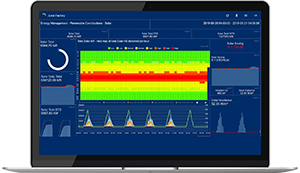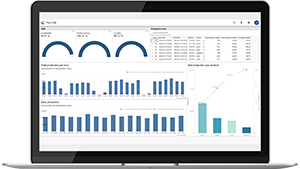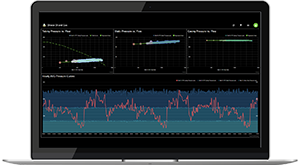Flow Analytics Framework
Model, Transform, and Distribute Information
Think of Flow as the information hub connecting your industrial information sources such as process historical data, business data, manually collected data and more to your data consumers.
As a hub, Flow provides a centralized place for data contextualization from the various sources, cleansing, and KPI calculations to be performed and managed at scale.
Flow empowers people across all functions and levels of an organization to make informed decisions more frequently… optimizing the operational effectiveness of our people, equipment and process investments. With Flow, everyone and everything that needs reliable data, has it.
Software Toolbox is an authorized Flow Software partner focusing on the US, Canada, & Mexico

-
Industries
-
How Flow Works
-
Historian & Database Connections
-
Cloud and IoT Connections
-
Manual Data Entry
-
Aggregations & Calculations
-
Backfilling for Quick Results
-
Accountability & Data Versioning
-
Visualization
-
Collaboration
-
Integrations - ERP, BI, MQTT & More
-
Templates
-
Enterprise Tiered Scalability
-
Security
Flow is used in a wide range of industries
- Food and beverage
- Consumer packaged goods
- Mining
- Metal processing
- Oil & Gas
- Utilities
- Renewable energy
- Healthcare

Flow Collaborates to Get the Job Done
Flow was born out of the frustration of users integrating data manually, with spreadsheets, and custom code and eventually running into the limitations of those systems.

- Collect data simultaneously from multiple disparate data sources
- Data is indexed, aggregated, and structured in Flow and results stored in the Flow database, ready for further use
- Calculation engine uses aggregated data stored in Flow to create additional KPIs and store those in flow. Data can be rolled up and contextualized by production and other events.
- Visualize, Notify, and Collaborate via charts and dashboards
- Notify via Flow Mobile email, SMS, Slack, etc.
- Integrate with ERP, BI, cloud, MQTT, and more.
Flexible historical data sources
- OPC HDA Historians
- OPC UA Historians
- Aveva (Wonderware) Historian
- Aveva Insight (Wonderware Online)
- Aveva (Wonderware) InTouch Local History (*.lgh files)
- Ignition Historian
- Canary Historian
- Microsoft SQL Server
- Microsoft Excel
- Oracle
- PostgreSQL
- MySQL
- InfluxDB
- Telegraf (buffer)
- MQTT (buffer)
- OPC UA (buffer)

Flexible Cloud Choices
Data sources
- RESTful web services
- Metering Online cloud energy system
- Apache Kafka
Upstream Integration
- MQTT - Sparkplug B, Custom, or Flow topic and payload definitions
- With Sparkplug B, the Flow model namespace is automatically made available for any client that can consume Sparkplug B definitions.
- Apache Kafka
- Azure Event Hub
- Microsoft SQL
- MySQL
- PostgresSQL
- CSV File Streaming
- AWS Kinesis Data Stream
- Amazon Timestream
- Canary Historian

Because not everything can be automated and things can still go wrong!
We know that you have important data that you just can't get to through digital integration yet. Flow enables you to create measures that are sourced through a brower-based spreadsheet like user interface, and later convert those measures to automated data collection.
Manual data entry is also be used for authenticated, commented, audit-logged update of automatically collected data, when things go wrong at the data source.

Making sense of raw data
The Flow Calculations engine, the measures you create using it, the events and flexible production schedules/shifts that provide context, is where the power of Flow lives.
Aggregations, automatically performed at the levels you want as time passes - hourly, shiftly, daily, weekly, quarterly, and annually - ensure the right data is already there when someone needs it. No waiting to reach back to historians and databases when you want an answer!
Calculations using the same common functions found in a spreadsheet along with user defined functions, including calculations that combine measures, give your data meaning.
Learn more in our video training

No need to wait to build up a data set - Backfill!
Flow is able to deliver fast value because as long as your historical data sources - historians, databases, etc - have the data for your time range of interest, Flow can backfill it's aggregated and calculated data at configuration time or any time in the future. And when you backfill, the system keeps on working while the backfill runs as the Flow Engine works in the background at a pace you control.
This means you could build a set of Flow measures, and quickly have data going back days, weeks, months, or more, which is helpful in validating your results, but also providing the instant ability to compare this week to last, this month to last, this month to same month a year ago, and more.
Flow also automatically backfills measures that depend on other measures when those measures change. Through Flow's data versioning you'll be able to know that the values were updated and why.
Lastly, if a historical data source is offline, and then comes back, Flow will automatically "catch up" on the collection measure and all dependent measures.

Who did it?
A big challenge with spreadsheet models is when users change something. You don't know who did it, when they did it, unless they remember to leave a comment. And if they break the model in the spreadsheet then what?
With Flow, through it's Active Directory Integration and user permissions, there is accountability on all configuration changes and manual data entry.

If a measure or event value is updated through backfilling, or configuration change, you'll be able to see past versions of the data, even revert back to those past versions if you have sufficient permissions.
If the person making a change leaves a comment you'll have that as well.

Extensive visual dashboards for Flow Data and more
Flow supports a wide range of types of tables, charts, widgets, gauges, and more. When you build a visual report in Flow, you can then combine those into a dashboard page, and then combine dashboard pages into dashboard loops, keeping everyone informed.

Staying together as a team
 To keep your team working together, all using the single version of the truth that you build, Flow offers these capabilities to deliver data, dashboards and more.
To keep your team working together, all using the single version of the truth that you build, Flow offers these capabilities to deliver data, dashboards and more.
- Email notifications
- Slack
- UNC file drop
- BulkSMS
- Twilio
- Microsoft Teams
Integrated collaboration with other systems
Once you've configured your Flow system, you'll have some great aggregated, meaningful data in your measures and reports. We're sure you will want to share that with other systems, so Flow has built in Data Consumers that automatically deliver calculated results to others without programming or integration middleware.
- ERP
- SQL
- BI (Business Intelligence)
- Machine Learning
- Cloud (multiple options)
- Other Flow systems in a tiered architecture

Scale your configuration with management templates
Many applications have multiple instances of the same type of metric, KPI, or other measure. To enforce standards and aid in rapid time to value deployment, Flow supports templates for measures, metrics, and folders, for use within a single Flow application and across multiple sites.
Templates can be locked to help enforce standards and roll out updates, even between sites. In multi-tiered applications you can designate a Flow system to be the "Template Server" to support your standards efforts.
Templates can be derived from other templates and thus linked so that derived templates can be synchronized with their parent template when there are changes.

Ready for distributed organizations and teams
Flow is ready for companies with multiple sites, the need for roll-up of information and the potential complexities that brings. Managed templates help enforce standards and provide configuration scalability.
Unlimited users, reports, charts, dashboards, data source types, data consumer integration types, and notification messages empower all to be "in the know" as required.

Windows Integrated Security
Flow's information portal supports http: and https: as well as TLS connections between the Flow Configuration app and Flow Application server.
Flow security integrates with Active Directory and enables you to limit usage at two levels and provides an audit trail of configuration changes.
- Restrict configuration functionality by user and group
- Secure forms, reports, and dashboards by user and group

SAMPLING OF FLOW APPLICATIONS
Here are just a few of the ways Flow is used. The software is designed for applications where you need to bring together differing historical data sources and derive meaningful metrics to support industrial operation decision making.
-
What are Measures?
-
What are Events?
-
Videos
-
Documentation
-
System Requirements
Measures - Time Series Data Building Blocks
A Measure in Flow Software is a KPI or metric you configure to collect and calculate information. Examples include volume produced, units produced, electricity used, production waste, production cost, efficiency, OEE, etc.
A Measure slices or aggregates your data into defined Calendar "time buckets" - hourly, shiftly, daily, etc.
Events: Delivering the non-time series context to your time series data
An Event in Flow Software is a value you retrieve from one of your data sources that you use to detect start and end of event periods that don't fall on even time intervals like hours, shifts, days, etc.
Examples include batch running, machine state, downtime, production runs, product being produced, work order, shift team, etc.
Events provide added context to your time series data and are key to making the intersection between historian and business information.
Helping you get started quickly with Flow
To assist you in learning flow, in addition to the Training Manual, we have a series of videos that walk you through a Flow system configuration.
Flow Training and Resource Manual

The Flow Training and Resource Manual provides 30 step-by-step hands on tutorials to guide you through installation, building a basic system, building basic reports, sending notifications and more. DOWNLOAD YOUR GUIDE
Operating System, Hardware, Software Requirements
Please visit our full FAQ for how to properly size a system. In general, though, here are basic requirements
- Windows 10 64-bit / 11 64-bit or Windows Server 2012 64-bit / 2012 R2 64-bit / 2016 64-bit / 2019 64-bit / 2022 64-bit
- You do NOT need to have IIS installed, Flow self-hosts it's webserver using .NET Core, and port used is configurable.
- .NET 6.0.x (ASP.NET Core Runtime - Hosting Bundle)
- .NET 6.0.x (Desktop Runtime - Flow Config Tool)
- Visual C++ Redistributable for Visual Studio 2012 Update 4**
- .NET 4.8 or higher ***
- Microsoft SQL Server 2019/2022 for Flow Database - Express Edition for starter/trial systems, Standard recommended for up to 10,000 measures and 200 events, Enterprise for larger.
- Chrome, Edge or Safari web browser
- ** If connecting to AVEVA Historian prior to the 2017 version as a data source, you also will need Visual C++ Redistributable for Visual Studio 2012 Update 4
- *** Required for AVEVA Historian Data Sources
Hardware Requirements
- Size Guideline:
- Demo Flow System - up to 100 measures and 10 events
- Starter Flow System - up to 1000 measures and 10 events
- Small Flow System - up to 10000 measures and 200 events
- Large Flow System - above 10000 measures or above 200 events
- For a Demo Flow System, all the components can be installed and run on a single machine for trial purposes. For a Production Flow System, please note the below requirements.
- Flow Config
- 16 GB minimum memory
- 5 GB minimum free disk space
- 32-bit color depth recommended
- 1920 by 1080 screen resolution recommended
- Flow Components (Engines and Server)
- 4 Cores, 2.0 GHz minimum CPU
- 32 GB minimum memory
- SQL Database Server Hardware
- Minimum - 4 Cores, 2.0 GHz minimum CPU
- Starter Flow: 16 GB minimum memory, 100 GB minimum free disk space
- Small Flow: 32 GB minimum memory, 200 GB minimum free disk space
- Large Flow: 64GB minimum memory, 500 GB minimum free disk space, SSD or faster technology drives
What Flow Users Have to Say
We initially used Flow for energy and water reporting but it has since grown and is being used for multiple KPIs across our breweries. No scripting experience required. Drag, drop and select what you want! It has removed the need for specialist development and has delivered an agile solution.
- Stuart Yates, Supply Chain and Technical Africa
You have built Excel into an automation platform.
- Louis Steyn, Exxaro Engineering Manager GMEP

Flow enables one to react quickly when things start to get out of control
- Henko Venter, Manufacturing Systems Manager
Get Started Now
The demo software is fully functioning for 30 days for up to 100 measures and 10 events. Systems built with trial software can be put into production by purchasing a Flow license.
Connect with Us
1-888-665-3678 (US + Canada toll free)
+1-704-849-2773 (Global)
support.softwaretoolbox.com
STAY CONNECTED
1-888-665-3678 (US + Canada)
+1-704-849-2773 (Global)
+1-704-849-6388 (Fax)
support.softwaretoolbox.com
WORKING WITH US
WHO WE ARE
RECENT POSTS
Usage subject to our website terms and conditions.





